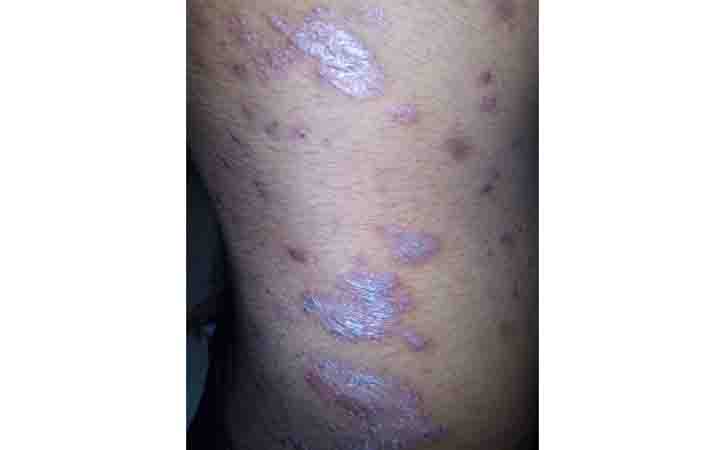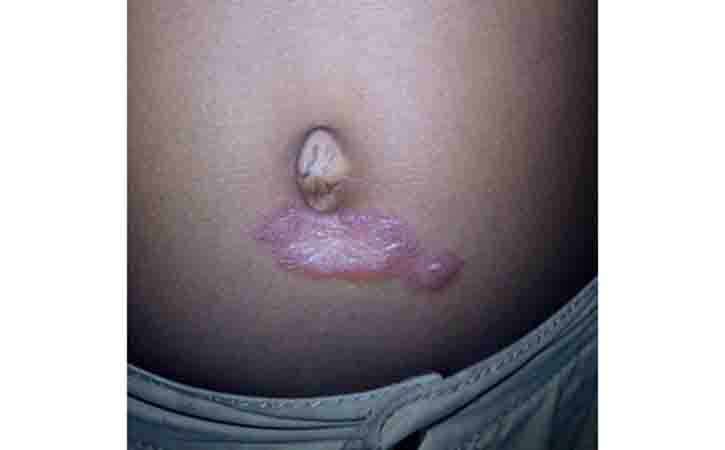Plaque Psoriasis
Plaque psoriasis is an inherited systemic inflammatory disease of immune dysfunction that causes plaques of elevated, scaling, inflamed skin that is often quite itchy. It is an autoimmune disease in which skin cells rapidly build up, forming scales and dry, itchy patches that flake off. Onset may be gradually or sudden.
The plaques are characteristically found on the scalp, elbows, and knees. Plaque psoriasis is relatively common; about 2%-3% of the population is affected. It is not contagious.
Plaque psoriasis causes raised, inflamed, red skin covered with silvery, white scales. Some causes remain a mystery, there are factors that can often trigger or worsen an outbreak, including obesity, stress, and smoking. Symptoms can be difficult to manage, but there is an ever-widening range of drugs that can temper the immune response and provide significant relief.
These patches may itch and burn. It can appear anywhere on the body, but often pops up in these areas:
- Elbows,
- Knees,
- Scalp,
- Lower back.

Psoriatic plaques are characterized as follows:
- Raised and easily palpable – Owing to the thickened epidermis, expanded dermal vascular compartment, as well as infiltrate of neutrophils and lymphocytes.
- Irregular to oval in shape.
- One to several centimeters in size.
- Well defined, with sharply demarcated boundaries.
- Very distinctive rich, full red color; lesions on the legs sometimes carry a blue or violaceous tint.
- Typically have a dry, thin, silvery-white or micaceous scale.
- Typically have a high degree of uniformity, with few morphologic differences between the 2 sides.
- Range in number from a few or many at any given time,
- Most often located on the scalp, trunk, and limbs, with a predilection for extensor surfaces, like: the elbows and knees.
- Symmetrically distributed over the body.
- May, in the case of smaller plaques, coalesce into larger lesions, especially on the legs and sacral regions.
Other manifestations of plaque psoriasis include the following:
- Pruritus – One of the main symptoms of plaque psoriasis.
- Nail psoriasis – Nails may exhibit pitting, onycholysis, subungual hyperkeratosis, or the oil-drop sign.
- Inverse psoriasis – A variant of psoriasis that spares the typical extensor surfaces and affects intertriginous areas (like axillae, inguinal folds, inframammary creases) with minimal scale.
- Psoriatic arthritis – occurs in approximately 10-20% of all cases of plaque psoriasis.
Manifestations of psoriatic arthritis include the following:
- Red, warm, tender, and inflamed joints.
- Joint deformity.
- Sausage digits.
Children
In children with plaque psoriasis, plaques are not as thick, and the lesions are less scaly. Psoriasis often appears in the diaper region in infancy and in flexural areas in children. The disease more commonly affects the face in children than it does in adults.



Like many other diseases, there is a significant interplay of genetic and environmental factors. Certain mutations pave the way for the development of the disease. Yet fully not understand the mechanisms behind autoimmune diseases like plaque psoriasis, but believe that a person’s genetics play a central role. Around a third of people with psoriasis will have a family history of the disease and evidence of chromosomal mutations on specific locations of a gene (known as PSORS1 through PSORS9).
Other causes of plaque psoriasis have been suggested, including past infections or toxic exposure, but most are hypothetical.
Whatever the trigger, plaque psoriasis will effectively accelerate the speed by which skin cells are produced. While normal skin cells are replaced every 28 to 30 days, those affected by plaque psoriasis are replaced every three to five days.
Because of this, new skin cells will accumulate faster than the old ones can be shed. At the same time, the blood vessels just beneath the skin will start to enlarge in response to the chronic inflammation, causing localized swelling and redness.
Topical agents: Topical agents used (often concurrently) to treat plaque psoriasis include the following:
- Corticosteroids
- Coal tar
- Anthralin
- Calcipotriene
- Tazarotene
Phototherapy
The 2 main forms of phototherapy are as follows:
Ultraviolet B (UVB) irradiation: UVB therapy is usually combined with one or more topical treatments.
Psoralen plus ultraviolet A irradiation (PUVA): This treatment uses the photosensitizing drug methoxsalen (8-methoxypsoralen) in combination with UVA irradiation to treat patients with more extensive disease.
Systemic therapy: Systemic treatment is initiated only after topical treatments and phototherapy have proved unsuccessful. Systemic therapy should also be considered for patients with very active psoriatic arthritis, as well as for patients whose disease is physical, psychologically, socially, or economically disabling.
Biologic therapy: Biologic therapies provide selective, systemic, immunologically directed interventions, including the following, at key steps in the pathogenesis of plaque psoriasis:
- Inhibition of the initial cytokine release and Langerhans cell migration.
- Targeting of activated T cells, prevention of further T-cell activation, and elimination of pathologic T cells.
- Blockage of interactions that lead to T-cell activation or migration into tissue
- Alteration of the balance of T-cell types.
- Inhibition of proinflammatory cytokines, such as tumor necrosis factor (TNF), interleukin (IL)–12, IL-17, and IL-23.
To confirm the analyze, need to consult with a doctor. Before use, the medication, also need to consult with a doctor.
- Oxford hand Book of medical Dermatology
- ABC Of Dermatology
- Clinical Dermatology
Plaque Psoriasis
TUI - Tibot Urgency Index


Plaque psoriasis is an inherited systemic inflammatory disease of immune dysfunction that causes plaques of elevated, scaling, inflamed skin that is often quite itchy. It is an autoimmune disease in which skin cells rapidly build up, forming scales and dry, itchy patches that flake off. Onset may be gradually or sudden.
The plaques are characteristically found on the scalp, elbows, and knees. Plaque psoriasis is relatively common; about 2%-3% of the population is affected. It is not contagious.
Plaque psoriasis causes raised, inflamed, red skin covered with silvery, white scales. Some causes remain a mystery, there are factors that can often trigger or worsen an outbreak, including obesity, stress, and smoking. Symptoms can be difficult to manage, but there is an ever-widening range of drugs that can temper the immune response and provide significant relief.
These patches may itch and burn. It can appear anywhere on the body, but often pops up in these areas:
- Elbows,
- Knees,
- Scalp,
- Lower back.



Psoriatic plaques are characterized as follows:
- Raised and easily palpable – Owing to the thickened epidermis, expanded dermal vascular compartment, as well as infiltrate of neutrophils and lymphocytes.
- Irregular to oval in shape.
- One to several centimeters in size.
- Well defined, with sharply demarcated boundaries.
- Very distinctive rich, full red color; lesions on the legs sometimes carry a blue or violaceous tint.
- Typically have a dry, thin, silvery-white or micaceous scale.
- Typically have a high degree of uniformity, with few morphologic differences between the 2 sides.
- Range in number from a few or many at any given time,
- Most often located on the scalp, trunk, and limbs, with a predilection for extensor surfaces, like: the elbows and knees.
- Symmetrically distributed over the body.
- May, in the case of smaller plaques, coalesce into larger lesions, especially on the legs and sacral regions.
Other manifestations of plaque psoriasis include the following:
- Pruritus – One of the main symptoms of plaque psoriasis.
- Nail psoriasis – Nails may exhibit pitting, onycholysis, subungual hyperkeratosis, or the oil-drop sign.
- Inverse psoriasis – A variant of psoriasis that spares the typical extensor surfaces and affects intertriginous areas (like axillae, inguinal folds, inframammary creases) with minimal scale.
- Psoriatic arthritis – occurs in approximately 10-20% of all cases of plaque psoriasis.
Manifestations of psoriatic arthritis include the following:
- Red, warm, tender, and inflamed joints.
- Joint deformity.
- Sausage digits.
Children
In children with plaque psoriasis, plaques are not as thick, and the lesions are less scaly. Psoriasis often appears in the diaper region in infancy and in flexural areas in children. The disease more commonly affects the face in children than it does in adults.



Like many other diseases, there is a significant interplay of genetic and environmental factors. Certain mutations pave the way for the development of the disease. Yet fully not understand the mechanisms behind autoimmune diseases like plaque psoriasis, but believe that a person’s genetics play a central role. Around a third of people with psoriasis will have a family history of the disease and evidence of chromosomal mutations on specific locations of a gene (known as PSORS1 through PSORS9).
Other causes of plaque psoriasis have been suggested, including past infections or toxic exposure, but most are hypothetical.
Whatever the trigger, plaque psoriasis will effectively accelerate the speed by which skin cells are produced. While normal skin cells are replaced every 28 to 30 days, those affected by plaque psoriasis are replaced every three to five days.
Because of this, new skin cells will accumulate faster than the old ones can be shed. At the same time, the blood vessels just beneath the skin will start to enlarge in response to the chronic inflammation, causing localized swelling and redness.
Topical agents: Topical agents used (often concurrently) to treat plaque psoriasis include the following:
- Corticosteroids
- Coal tar
- Anthralin
- Calcipotriene
- Tazarotene
Phototherapy
The 2 main forms of phototherapy are as follows:
Ultraviolet B (UVB) irradiation: UVB therapy is usually combined with one or more topical treatments.
Psoralen plus ultraviolet A irradiation (PUVA): This treatment uses the photosensitizing drug methoxsalen (8-methoxypsoralen) in combination with UVA irradiation to treat patients with more extensive disease.
Systemic therapy: Systemic treatment is initiated only after topical treatments and phototherapy have proved unsuccessful. Systemic therapy should also be considered for patients with very active psoriatic arthritis, as well as for patients whose disease is physical, psychologically, socially, or economically disabling.
Biologic therapy: Biologic therapies provide selective, systemic, immunologically directed interventions, including the following, at key steps in the pathogenesis of plaque psoriasis:
- Inhibition of the initial cytokine release and Langerhans cell migration.
- Targeting of activated T cells, prevention of further T-cell activation, and elimination of pathologic T cells.
- Blockage of interactions that lead to T-cell activation or migration into tissue
- Alteration of the balance of T-cell types.
- Inhibition of proinflammatory cytokines, such as tumor necrosis factor (TNF), interleukin (IL)–12, IL-17, and IL-23.
To confirm the analyze, need to consult with a doctor. Before use, the medication, also need to consult with a doctor.
- Oxford hand Book of medical Dermatology
- ABC Of Dermatology
- Clinical Dermatology




